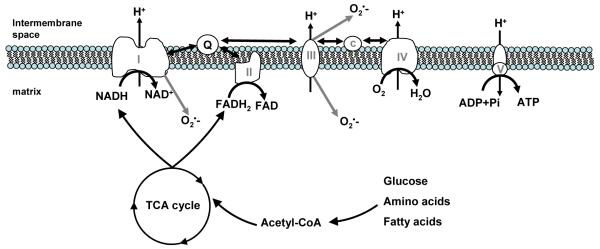Figure 1.
Mitochondrial ATP synthesis is coupled to fuel oxidation in the tricarboxylic acid (TCA) cycle. Acetyl CoA, derived from glucose, amino acids and fatty acids, is oxidized in the TCA cycle to produce reducing equivalents in the form of NADH and FADH2. NADH is oxidized by complex I (HADH dehydrogenase), while complex II (succinate dehydrogenase) oxidizes succinate to reduce FADH to FADH2. Electron flow from complexes I and II converge on a mobile electron carrier, Coenzyme Q, which transfers electrons to complex III (coenzyme Q-cytochrome c reductase). A second mobile electron carrier, cytochrome c, transfers electrons to complex IV (cytochrome c oxidase). Passage of electron pairs through respiratory chain complexes I, III, and IV results in proton transport across the inner mitochondrial membrane. The resulting proton gradient is used to drive the phosphorylation of ADP at complex V (ATP synthase). Gray arrows indicate sites of superoxide (O2·−) production at complexes I and III.

